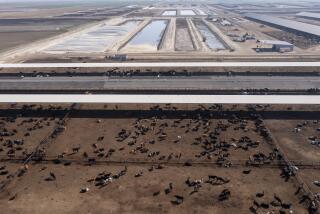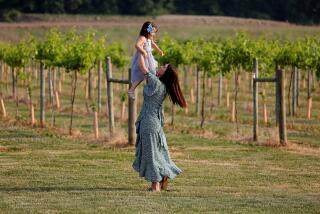Rural Renaissance Helping a Thousand Small Towns Bloom
- Share via
BONAPARTE, Iowa — When this mite-sized town seemed to be slouching toward oblivion, it found salvation in a most unlikely source: the local phone book.
Just five pages long, the slender directory became a blueprint for rescuing Bonaparte after its main strip of stores was put up for sale. No one wanted to buy them all, and the end appeared near.
No businesses, no Bonaparte, so it seemed. No way, said four men devoted to this hamlet of 465. So they designed a plan, divvied up the phone book and began dialing for dollars, asking townsfolk to pitch in $2,000 each to become partners in the local stores.
Ten days later, they had 50 investors and $100,000. A crisis had been averted. Bonaparte had escaped its Waterloo.
This spring, Bonaparte received national recognition for its revival. And now, a decade after the SOS (Save Our Stores) call went out, the 159-year-old town is beginning to reap rewards, albeit small ones: It is welcoming new businesses, new residents, even a sprinkling of tourists.
“We’ve made it. It’s been a long battle,” said Mike Gunn, a businessman who helped design and invested in the partnership. “The economics of small towns are tough, but we are surviving. . . . We’re not going to fail.”
Credit must go to people here, said town clerk Connie Meek.
“You don’t wait for the world to save you. You have to go out and see what’s there for yourself,” she said.
Bonaparte’s success is just one chapter in a success story being written in small towns across the nation’s heartland. Rural America, drained by the farm crisis of the ‘80s and an exodus of people, jobs and businesses, is basking in its first renaissance in a generation.
“We’re calling it the rural rebound,” said Ken Johnson, a demographer at Loyola University in Chicago. “The change is not only because more people are coming into those areas, but fewer people are leaving.”
The rate of population increase in rural America is more than three times greater in the 1990s than it was in the ‘80s, and more than 75% of rural counties grew from 1990 to 1994, according to research coauthored by Johnson.
While 1.4 million rural residents packed up and headed out during the bleak ‘80s, the research found, 1.6 million people migrated in during the first half of this decade.
In Iowa, where nearly 60% of the towns grew from 1990 to 1994 (compared with eight of 10 shrinking in the 1980s), the new confidence is evident on Main Street: A recent Iowa State University study of merchants in 30 communities found more than half planned to expand.
Despite the optimism, not all regions are coming back. Parts of the Great Plains, Mississippi Delta and Midwest, including mining and farm communities, still are on the decline.
In contrast, the fastest-growing spots are outside metropolitan areas and retirement and recreation communities in the Sunbelt, Ozarks, Upper Great Lakes and mountain West, according to Johnson’s study.
Otsego County, in north-central Michigan, for one, posted a 15.6% population increase in the first half of the ‘90s; many newcomers are Detroit-area retirees.
There’s something old, something new in the revival. One attraction is the Norman Rockwell appeal--homes that don’t need locks, streets without traffic jams, neighbors who know each other’s names.
Dan Bentler, who manages Bonaparte’s hardware store, left town after high school and lived in Dallas for several years, never expecting to return. But Iowa’s slower pace and safer environment for his two daughters lured him back in February.
“You don’t recognize what you have until you don’t have it anymore,” said the burly 33-year-old, as he painted his Victorian house. “Some days, you don’t have a worry in the world. We see being here the rest of our lives now, which I couldn’t see when I was in high school.”
There’s a ‘90s element, too, in this reversal of fortune. Computers and telecommuting allow people to work at home--and more are choosing remote areas. Technology also gives companies wide berth.
In Winner, S.D., a one-stoplight town on a vast stretch of prairie, the Ramada hotel chain opened a reservation center in 1994 in a vacant downtown building. It generates a $1.6-million payroll in a community of 3,400, employing up to 300 people (in summer), including teachers, ministers, farmers and college students.
“The telephone lines are here,” said Brad Schramm, president of the Independent Motels of America, housed in the same building. “You don’t need trucking companies. You don’t need railroads. You just need high-quality people to come to work.”
“There’s a lot of extra income now, so people can afford to remodel their house or buy a different car,” he added. “It just makes for a slightly better way of life.”
Economic advantages are so inviting--a $200,000 home in Los Angeles, for instance, might sell for $60,000 in Iowa--that some city residents relocate without work.
“You can sit out there two, three years and try to figure out a way to make a living,” said Ken Munsell, director of the Small Towns Institute in Washington state. “Often, that will translate into a new downtown business--that’s assuming the whole town hasn’t been swallowed up by Wal-Mart, which happens too frequently.”
In fact, the discount chain has shaken up Main Street. In Iowa, Wal-Mart opened 50 stores in a 10-year period ending in 1993 and, in that time, towns of 500 to 1,000 lost 47% of their retail sales, said Ken Stone, an Iowa State economics professor.
That squeeze forces some towns to pursue opportunities they once would have rejected--such as prisons. More than half those built in the last decade are in rural America, even though just 20% of the nation lives there, said Calvin Beale, a U.S. Agriculture Department demographer who coauthored the population research.
“The punishment of urban crime has become a rural growth industry,” he said. “It’s kind of sad, but true--so many rural communities are so desperate, they are willing to seek prisons even though they wouldn’t have a decade ago.”
Other towns take a more traditional route.
Duncan, Okla., about 50 miles from Texas, was so battered by the ‘80s oil recession that Main Street was half-vacant a decade ago and the job market remained stagnant until 1994, Mayor Phil Leonard said.
Since then, aggressive recruiting, the restoration of old buildings, a sales tax increase and frustration with growing congestion around the nearby mall have energized the town.
Leonard said that Duncan has commitments for about 3,000 jobs by the end of next year and that downtown is almost totally occupied. Recently, he witnessed a joyous sight--traffic.
“Oh, my heavens, I remember 10 years ago, in the middle of the afternoon, you could count five cars coming down Main Street,” he said. “Last Friday, for the first time, I saw people circling because there was not a parking space. It made me feel great.”
Bonaparte has its own scrappy turnaround tale.
Bordering the Des Moines River on the southeast corner of the state, Bonaparte--a nearby city was supposed to be named Napoleon, but never got off the ground--once was a prosperous town with factories and woolen and grist mills.
It had been declining for decades when the elderly owners of a shopping center that formed the core of downtown--offering everything from steaks to shoes to screws--decided in 1986 to sell it.
“Death was knocking at the door,” said Rebecca Reynolds-Knight, the former mayor. “One person suggested we tear it all down and put up parking lots.”
Instead, collective ownership was proposed. Calls were made and a town meeting held, and 50 investors signed on the dotted line.
“Everyone wants a little town to survive,” said Mayor Mark Meek, whose ancestors founded Bonaparte. “When they put their money where their mouth is, that’s commitment.”
Shares were limited to $2,000 to avoid major losses if the plan failed.
It didn’t.
Today, Township Stores Inc. owns and operates the local grocery and hardware and two condos, and rents space to doctors, the school district and a beauty shop.
The 19th century redbrick buildings were renovated and spruced up with striped-green awnings and benches, as was the beige-and-turquoise old Opera House, part of which became a community center.
All that work was jeopardized when the Midwest floods of ’93 swallowed downtown for a month, but farmers and residents bailed it out.
Since then, a bed-and-breakfast and a crafts store have opened. In June, an antiques mall and art store followed, though several buildings downtown remain vacant.
Bonaparte has rebounded enough for the National Trust for Historic Preservation to honor it with a Main Street award for its revitalization, but no one here is complacent.
“The stores are open,” the mayor said. “There are younger people moving in. We’re not declining in growth. It’s a step in the right direction. We’re over the hump, but it’s a long way from being down the hill.”
More to Read
Sign up for Essential California
The most important California stories and recommendations in your inbox every morning.
You may occasionally receive promotional content from the Los Angeles Times.













